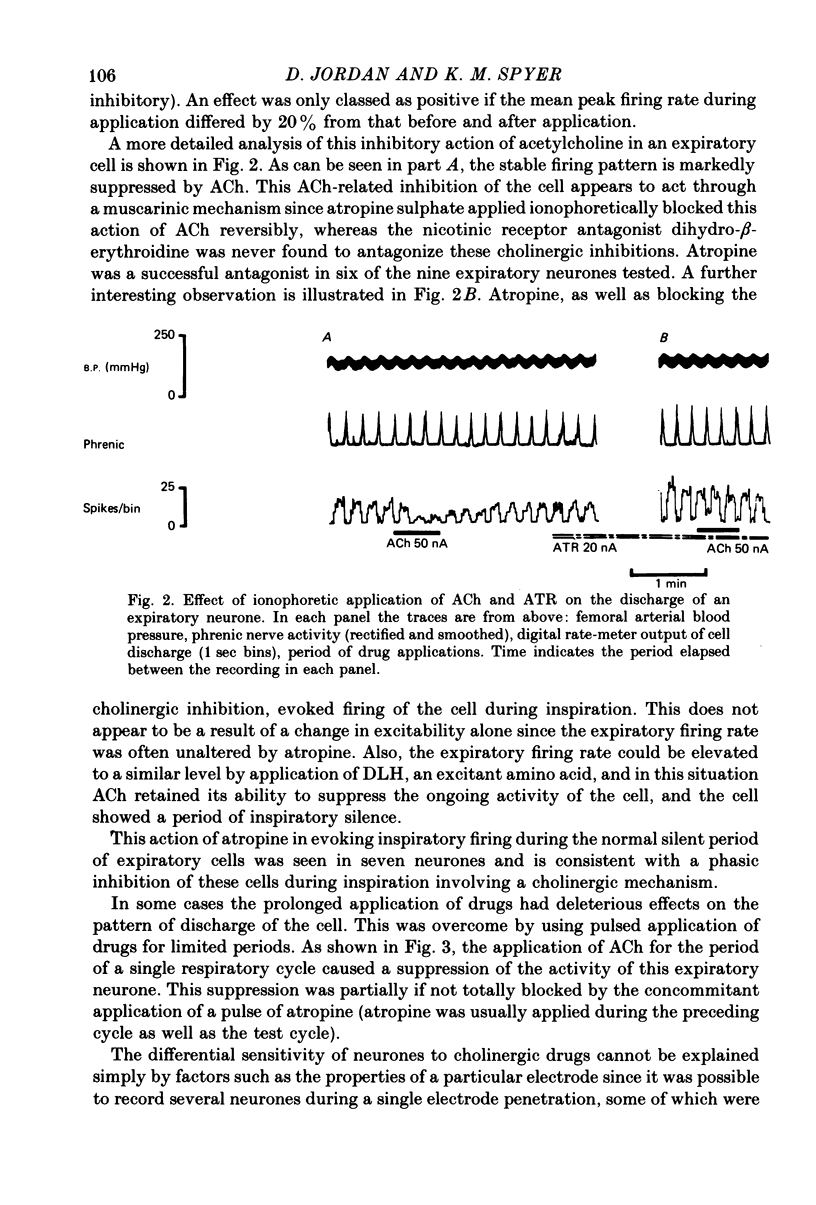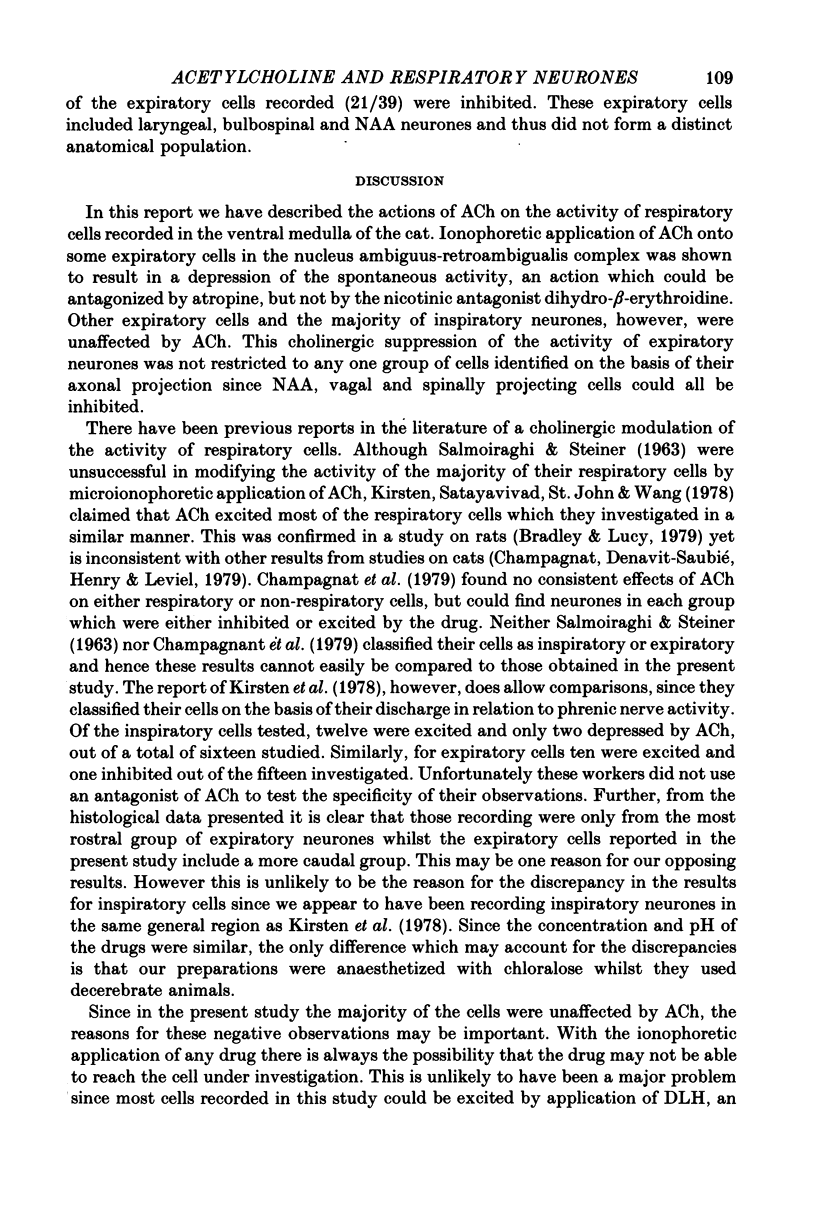Abstract
1. The effects of ionophoretic application of acetylcholine (ACh) and cholinergic antagonists to respiratory neurones of the nucleus ambiguus-retroambigualis complex were studied in cats. 2. Acetylcholine was ineffective when applied to inspiratory neurones (27/31) but inhibited the spontaneous activity of a significant population of expiratory neurones (21/39). 3. The expiratory neurones inhibited by ACh included neurones with axons projecting to the vagus or spinal cord, as well as neurones not antidromically activated from either of these sites. 4. The cholinergic inhibition of expiratory neurones was blocked by atropine (6/9) but dihydro-beta-erythroidine was ineffective. In seven expiratory neurones, ionophoresis of atropine alone evoked firing during the normal period of silence of the neurone (inspiration). 5. It is concluded that a significant population of expiratory neurones receive an active inhibition during inspiration and this involves a cholinergic mechanism. The implications of these observations for the synaptology of central respiratory control and modifications of the vagal outflow to the heart are discussed.
Full text
PDF








Selected References
These references are in PubMed. This may not be the complete list of references from this article.
- Bianchi A. L. Localisation et étude des neurones respiratoires bulbaires. Mise en jeu antidromique par stimulation spinale ou vagale. J Physiol (Paris) 1971 Jan-Feb;63(1):5–40. [PubMed] [Google Scholar]
- Champagnat J., Denavit-Saubié M., Henry J. L., Leviel V. Catecholaminergic depressant effects on bulbar respiratory mechanisms. Brain Res. 1979 Jan 5;160(1):57–68. doi: 10.1016/0006-8993(79)90600-0. [DOI] [PubMed] [Google Scholar]
- Hellon R. F. The marking of electrode tip positions in nervous tissue. J Physiol. 1971;214 (Suppl):12P–12P. [PubMed] [Google Scholar]
- Jordan D., Spyer K. M. Studies on the termination of sinus nerve afferents. Pflugers Arch. 1977 May 6;369(1):65–73. doi: 10.1007/BF00580812. [DOI] [PubMed] [Google Scholar]
- Kirsten E. B., Satayavivad J., St John W. M., Wang S. C. Alteration of medullary respiratory unit discharge by iontophoretic application of putative neurotransmitters. Br J Pharmacol. 1978 Jun;63(2):275–281. doi: 10.1111/j.1476-5381.1978.tb09757.x. [DOI] [PMC free article] [PubMed] [Google Scholar]
- Kreuter F., Richter D. W., Camerer H., Senekowitsch R. Morphological and electrical description of medullary respiratory neurons of the cat. Pflugers Arch. 1977 Nov 25;372(1):7–16. doi: 10.1007/BF00582200. [DOI] [PubMed] [Google Scholar]
- Lipski J., McAllen R. M., Spyer K. M. The sinus nerve and baroreceptor input to the medulla of the cat. J Physiol. 1975 Sep;251(1):61–78. doi: 10.1113/jphysiol.1975.sp011081. [DOI] [PMC free article] [PubMed] [Google Scholar]
- METZ B. Brain acetylcholinesterase and a respiratory reflex. Am J Physiol. 1958 Jan;192(1):101–105. doi: 10.1152/ajplegacy.1957.192.1.101. [DOI] [PubMed] [Google Scholar]
- McAllen R. M., Spyer K. M. The baroreceptor input to cardiac vagal motoneurones. J Physiol. 1978 Sep;282:365–374. doi: 10.1113/jphysiol.1978.sp012469. [DOI] [PMC free article] [PubMed] [Google Scholar]
- McAllen R. M., Spyer K. M. Two types of vagal preganglionic motoneurones projecting to the heart and lungs. J Physiol. 1978 Sep;282:353–364. doi: 10.1113/jphysiol.1978.sp012468. [DOI] [PMC free article] [PubMed] [Google Scholar]
- SALMOIRAGHI G. C., STEINER F. A. Acetylcholine sensitivity of cat's medullary neurons. J Neurophysiol. 1963 Jul;26:581–597. doi: 10.1152/jn.1963.26.4.581. [DOI] [PubMed] [Google Scholar]


